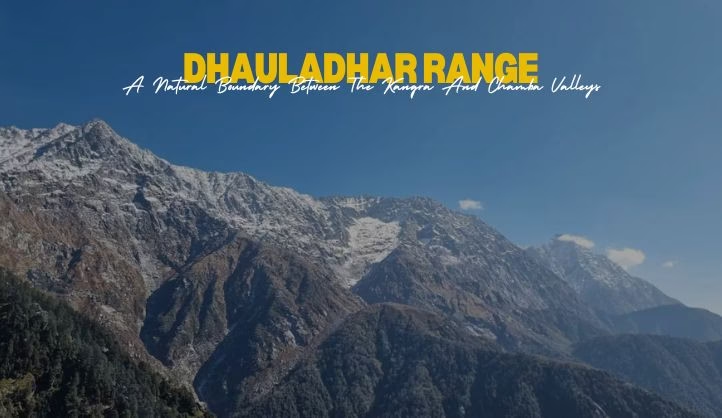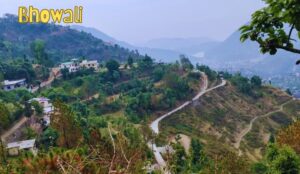The Dhauladhar range, a majestic mountain chain in the state of Himachal Pradesh, is part of the outer Himalayan range. The word “Dhauladhar” means “white ridge” in Sanskrit, reflecting its snow-clad peaks that tower over the picturesque landscapes of northern India. This range is a haven for nature lovers, trekkers, and spiritual seekers alike. Let’s dive into a detailed exploration of the Dhauladhar range, covering its geography, trekking trails, cultural significance, and much more.
Geography of the Dhauladhar Range
The Dhauladhar range stretches across Himachal Pradesh, forming a natural boundary between the Kangra and Chamba valleys. The range extends from Dalhousie in the west to the higher reaches of the Kullu and Manali valleys in the east. Its rugged cliffs, deep gorges, and snow-covered peaks make it a sight to behold.
The range is characterized by sharp, craggy peaks and steep slopes, making it one of the more challenging mountain ranges for trekkers and mountaineers. The highest peak in the range is Hanuman Tibba, which stands tall at 5,982 meters (19,626 feet). Other notable peaks include Gaurjunda and Mun Peak.
Climate and Best Time to Visit
The climate in the Dhauladhar range varies significantly depending on the altitude. The lower regions experience a temperate climate, while the higher altitudes are covered with snow for most of the year.
- Summer (April to June): Ideal for trekking and sightseeing, with temperatures ranging from 15°C to 25°C.
- Monsoon (July to September): Heavy rainfall occurs, making trekking risky due to landslides and slippery trails.
- Autumn (October to November): Clear skies and pleasant weather make it one of the best times to visit.
- Winter (December to March): Snowfall is common, and the region becomes a paradise for snow lovers. However, trekking during this time is only for experienced adventurers.
The best time to visit the Dhauladhar range is from April to June and October to November when the weather is most favorable.
Popular Trekking Trails in the Dhauladhar Range
The Dhauladhar range offers some of the most scenic and challenging trekking routes in India. Here are a few popular ones:
1. Triund Trek
One of the most popular treks in Himachal Pradesh, the Triund trek offers panoramic views of the Kangra valley and the Dhauladhar mountains. The trek starts from McLeod Ganj and takes around 4-6 hours to complete. It’s a moderate trek, making it suitable for beginners.
2. Kareri Lake Trek
Kareri Lake is a high-altitude freshwater lake situated at an elevation of around 2,950 meters. The trek begins from Kareri village and takes trekkers through dense pine forests, scenic meadows, and rocky terrains. The crystal-clear lake, fed by melting snow from the Dhauladhar range, is the highlight of this trek.
3. Indrahar Pass Trek
The Indrahar Pass trek is one of the more challenging routes, taking trekkers to an altitude of 4,342 meters. The trek begins from McLeod Ganj and passes through the scenic Lahesh Caves and Triund. The pass offers breathtaking views of the Kangra Valley and the Pir Panjal range.
4. Minkiani Pass Trek
This lesser-known trek is perfect for adventure seekers looking for solitude. The trail passes through dense forests, alpine meadows, and rocky terrains. The Minkiani Pass, situated at an altitude of 4,350 meters, offers stunning views of the Dhauladhar range and surrounding valleys.
Spiritual Significance of the Dhauladhar Range
The Dhauladhar range holds significant spiritual importance for the local communities and visitors alike. Numerous temples, monasteries, and meditation centers are nestled within its valleys and slopes. Some notable spiritual sites include:
- Bhagsunath Temple: Located near McLeod Ganj, this ancient temple dedicated to Lord Shiva is a popular pilgrimage site.
- Dalai Lama Temple Complex: The spiritual headquarters of the Tibetan community in exile, this temple is a major attraction in McLeod Ganj.
- Chamunda Devi Temple: Situated near this mountain chain, this temple is dedicated to Goddess Chamunda, a fierce form of Goddess Durga.
The serene environment and breathtaking views make the Dhauladhar range an ideal destination for meditation and spiritual retreats.
Flora and Fauna
This range is home to a diverse range of flora and fauna. The lower slopes are covered with dense forests of pine, deodar, and oak trees. As you ascend higher, the vegetation changes to alpine meadows and shrubs.
The region is also rich in wildlife, with sightings of Himalayan black bears, leopards, langurs, and barking deer. Bird enthusiasts can spot various species of pheasants, partridges, and vultures. The endangered Western Tragopan, also known as the “Jewel of Himachal Pradesh,” can be found in the higher reaches of the range.
Adventure Activities in the Dhauladhar Range
Apart from trekking, the Dhauladhar range offers numerous adventure activities for thrill-seekers:
- Paragliding: Bir-Billing, located near the Dhauladhar range, is one of the world’s top paragliding destinations.
- Camping: Triund and Kareri Lake are popular camping spots, offering a night under the stars with breathtaking mountain views.
- Rock Climbing: The rugged cliffs and steep slopes of the Dhauladhar range provide excellent opportunities for rock climbing and bouldering.
- Snowboarding and Skiing: During winter, the snow-covered slopes are perfect for skiing and snowboarding.
Cultural and Local Life
This range is home to various indigenous communities, including the Gaddi tribe. The Gaddis are primarily shepherds and are known for their semi-nomadic lifestyle. Their culture, traditions, and festivals add a unique charm to the region.
Visitors can experience the local way of life by staying in homestays, sampling traditional Himachali cuisine, and participating in local festivals. The hospitality of the local people is one of the highlights of a visit to the Dhauladhar range.
How to Reach the Dhauladhar Range
The Dhauladhar range is well-connected to major cities in Himachal Pradesh and neighboring states. Here’s how you can reach the region:
- By Air: The nearest airport is Gaggal Airport (Dharamshala Airport), located about 15 km from McLeod Ganj.
- By Train: The nearest railway station is Pathankot, about 85 km away. From there, you can take a taxi or bus to Dharamshala or McLeod Ganj.
- By Road: The region is well-connected by road to major cities like Delhi, Chandigarh, and Shimla. Regular buses and taxis are available.
Tips for Visiting the Dhauladhar Range
- Pack Properly: Carry warm clothing, even in summer, as temperatures can drop suddenly at higher altitudes.
- Stay Hydrated: High-altitude trekking can lead to dehydration, so drink plenty of water.
- Hire a Guide: For challenging treks, hiring a local guide is recommended to ensure safety.
- Respect Nature: Follow the principles of Leave No Trace to preserve the natural beauty of the region.
Conclusion
The Dhauladhar range is a treasure trove of natural beauty, adventure, and cultural richness. Whether you’re a trekker, nature lover, or spiritual seeker, this magnificent mountain range has something to offer everyone.
FAQs About the Dhauladhar Range
1. What is the highest peak in the Dhauladhar range?
The highest peak in the Dhauladhar range is Hanuman Tibba, which stands at 5,982 meters.
2. Is the Triund trek suitable for beginners?
Yes, the Triund trek is moderate and is suitable for beginners with basic fitness levels.
3. When is the best time to visit the Dhauladhar range?
The best time to visit is from April to June and October to November when the weather is pleasant and the skies are clear.
4. Are there any wildlife sanctuaries in the Dhauladhar range?
Yes, the Dhauladhar range is home to a variety of wildlife, including Himalayan black bears, leopards, and the endangered Western Tragopan.
5. What adventure activities can I do in the Dhauladhar range?
You can enjoy trekking, paragliding, camping, rock climbing, and skiing in the Dhauladhar range.





